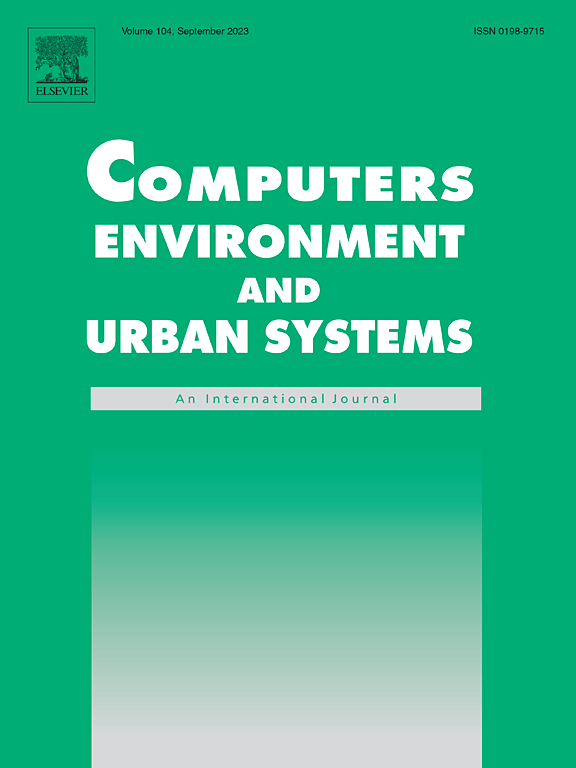费城公交车站周围的超局部热应力:来自时空微气候模型和可解释人工智能的见解
IF 8.3
1区 地球科学
Q1 ENVIRONMENTAL STUDIES
Computers Environment and Urban Systems
Pub Date : 2025-09-02
DOI:10.1016/j.compenvurbsys.2025.102341
引用次数: 0
摘要
城市热岛效应严重影响公共交通用户,特别是那些在公交车站等待的人,他们长期暴露在极端高温下会带来健康风险。尽管人们越来越关注气候适应能力,但有限的研究集中在公交车站的超局部、行人水平的热应力或其与周围城市环境的关系上。为了解决这一差距,我们利用高分辨率、多源地理空间数据和小气候建模,为费城生成了每小时1米分辨率的通用热气候指数(UTCI)地图,详细捕捉了8000多个公交车站附近夏季白天的时空热应力模式。我们进一步开发了一个可解释的机器学习框架,结合随机森林(RF)和SHAP分析来揭示热应力与建筑环境和社会经济变量之间复杂的非线性关系和阈值效应。主要发现包括:(1)热应激的时空差异显著,中午时全市热应激水平持续较高;(2)低收入社区公交车站周围的热应力较高,而较富裕地区(如家庭中位数较高)的热暴露程度较低;(3)绿色景观指数(GVI)和围护是最有效的热缓解特征;(4)城市主要指标的复杂阈值效应突出了有针对性和公平的干预措施对减少脆弱地区热应激的重要性。本文章由计算机程序翻译,如有差异,请以英文原文为准。
Hyperlocal heat stress around bus stops in Philadelphia: Insights from spatio-temporal microclimate modeling and explainable AI
The Urban Heat Island (UHI) effect significantly impacts public transit users, particularly those waiting at bus stops, where prolonged exposure to extreme heat poses health risks. Despite increasing attention to climate resilience, limited research has focused on hyperlocal, pedestrian-level thermal stress at bus stops or its relationship with the surrounding urban environment. To address this gap, we generated hourly 1-meter resolution Universal Thermal Climate Index (UTCI) maps for Philadelphia using high-resolution, multi-source geospatial data and microclimate modeling, capturing detailed summer daytime spatio-temporal heat stress patterns around more than 8,000 bus stops. We further developed an explainable machine learning framework, combining Random Forest (RF) and SHAP analysis to uncover complex, nonlinear relationships and threshold effects between heat stress and both built environment and socioeconomic variables. Key findings include: (1) Significant spatio-temporal variation in heat stress, with consistently high levels at midday across the city; (2) Higher heat stress around bus stops located in low-income neighborhoods, while more affluent areas (e.g., higher median household value) exhibit reduced thermal exposure; (3) Green View Index (GVI) and Enclosure emerged as the most effective heat-mitigating features, and (4) complex threshold effects across key urban indicators highlight the importance of targeted and equitable interventions to reduce heat stress in vulnerable areas.
求助全文
通过发布文献求助,成功后即可免费获取论文全文。
去求助
来源期刊

Computers Environment and Urban Systems
Multiple-
CiteScore
13.30
自引率
7.40%
发文量
111
审稿时长
32 days
期刊介绍:
Computers, Environment and Urban Systemsis an interdisciplinary journal publishing cutting-edge and innovative computer-based research on environmental and urban systems, that privileges the geospatial perspective. The journal welcomes original high quality scholarship of a theoretical, applied or technological nature, and provides a stimulating presentation of perspectives, research developments, overviews of important new technologies and uses of major computational, information-based, and visualization innovations. Applied and theoretical contributions demonstrate the scope of computer-based analysis fostering a better understanding of environmental and urban systems, their spatial scope and their dynamics.
 求助内容:
求助内容: 应助结果提醒方式:
应助结果提醒方式:


